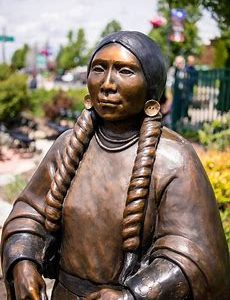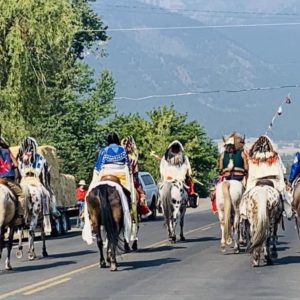Return of the Nez Perce
In 1877 the Nez Perce were driven from their ancestral lands in the Wallowa Mountains of Eastern Oregon. One of the big stories of the last twenty years is their gradual return and growing influence of the tribe here.
 Yesterday marked another step on this journey, a especially moving one, as the Tribe celebrated attaining a conservation easement on the 9.22 acres that surround the historic Wallowa Lake Lodge. This is especially important, not only for preserving the unique beauty of that property, but because it includes the riparian zone where the Wallowa River enters Wallowa Lake, a critical ecological niche. (At right, sculpture by Doug Hyde, “I Return from a Difficult Journey” at Josephy Center for Arts and Culture in Joseph, Oregon)
Yesterday marked another step on this journey, a especially moving one, as the Tribe celebrated attaining a conservation easement on the 9.22 acres that surround the historic Wallowa Lake Lodge. This is especially important, not only for preserving the unique beauty of that property, but because it includes the riparian zone where the Wallowa River enters Wallowa Lake, a critical ecological niche. (At right, sculpture by Doug Hyde, “I Return from a Difficult Journey” at Josephy Center for Arts and Culture in Joseph, Oregon)
That particular story started in 2015 when the Lodge was up for sale and large development companies like Hilton and Hyatt were very interested. Moreover, the Lodge’s surrounding property was zoned for luxury homes and up to 52 condominiums. Seeing a treasure at risk, local citizens banded together to purchase the Lodge, a bid which the seller supported and facilitated. Today the Lodge has become a music and cultural center in addition to continuing as a lodging and dining facility. The celebration of the conservation easement to the Nez Perce Tribe was an important next step in the process of Nez Perce return, but also a key move in the visionary effort to return the Sockeye Salmon species to Wallowa Lake.
A big player in all this, and really throughout the region is the Tribe’s Department of Fisheries Resource Management. DFRM is playing the long game, working at habitat restoration and re-introduction of fish species to a watershed that includes the Wallowa, Lostine and Minam Rivers, before joining the Grande Ronde and the Snake River systems. Current efforts to restore the Sockeye face their biggest obstacle in the four dams on the Lower Snake River.
 In 2020 the Nez Perce celebrated another milestone by purchasing 148 acres, including stream habitat, on the southwest side of the town of Joseph, Oregon. Am’saaxpa or “The Place of Boulders” was dedicated in ceremonies (photo at right) last year.
In 2020 the Nez Perce celebrated another milestone by purchasing 148 acres, including stream habitat, on the southwest side of the town of Joseph, Oregon. Am’saaxpa or “The Place of Boulders” was dedicated in ceremonies (photo at right) last year.
Ten years earlier the nearby area of Iwetemlaykin, which means “At the Edge of the Lake” was set aside as a State Park. It is the area where tribal members, for centuries, spent summer months harvesting Sockeye, and drying the fish for winter sustenance. Like the Lodge property, both Iwetemlaykin and Am’saaxpa were properties for which outside developers had big plans.
There are other signs of the growing tribal presence including a Tribal Center just outside the town of Wallowa where the annual Tamkaliks celebration, being held this weekend, is a reunion celebration of all Nez Perce who live today in three principal areas, the Lap’wai Reservation in Idaho, in the Colville area of Washington, and on the Umatilla Reservation closer to Pendleton, Oregon.
But this is part of a larger story unfolding across the nation, one symbolized by the appointment of Deb Haaland, a Native American, as the Secretary of the Interior in the Biden Administration. Across the country Native Tribes are an increasingly significant player on many fronts.
“It seems,” noted Rich Wandschneider, the co-founder of the summer writer’s gathering, Fishtrap, “that we (whites) having made a mess of creation are now, belatedly, turning to native people’s for help.” This year’s Fishtrap Gathering was itself was another step in the Nez Perce return as the keynote presentation was made by five Nimiipuu (Nez Perce) writers and artists who comprise “The North Star Collective.”
“Nez Perce” is an exonym, a name give to a group by those who are not part of it. The Nez Perce name for themselves, Nimiipuu, means simply, “the people.” In many and various ways, the Nimiipuu have ceased to be regarded as a colorful remnant of the past to claim a role as a major force in the present in the Eastern Oregon, Washington and Idaho region of 7.5 million acres guaranteed to the Tribe in the 1855 Walla Walla Treaty. Though that Treaty has been broken multiple times by the U.S., it remains a solid legal leg to stand on for the Nimiipuu to assert their interests and contribute their perspective and wisdom.
![Anthony B. Robinson [logo]](https://www.anthonybrobinson.com/wp-content/themes/anthonybrobinson/images/logo.png)
![Anthony B. Robinson [logo]](https://www.anthonybrobinson.com/wp-content/themes/anthonybrobinson/images/logo-print.png)